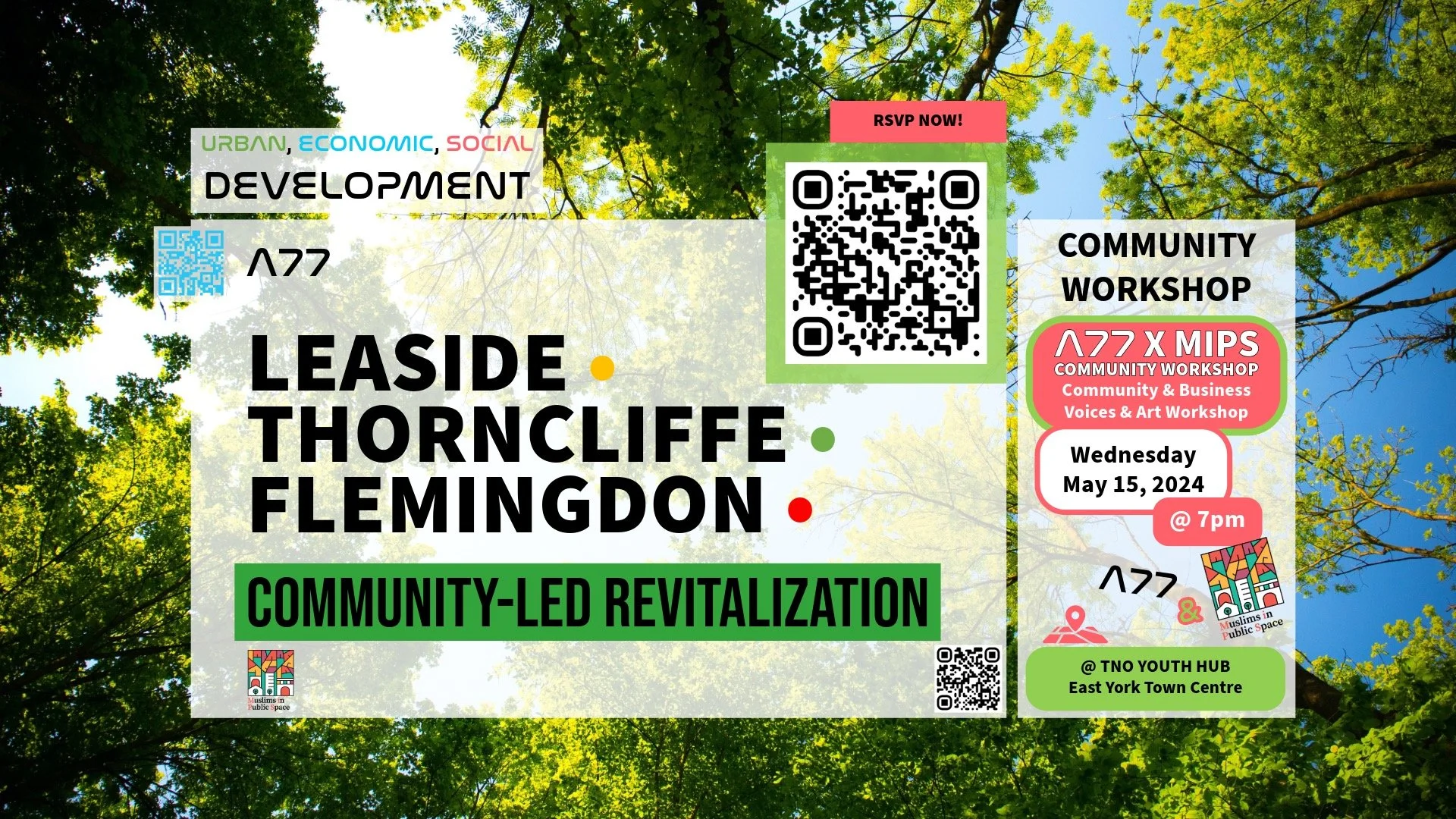
LEASIDE •
THORNCLIFFE •
FLEMINGDON •
COMMUNITY-LED REVITALIZATION
COLLABORATING ORGANIZATIONS:
COMMUNITY REVITALIZATION.
COMMUNITY AND CULTURAL PRESERVATION.
URBAN, ECONOMIC, SOCIAL DEVELOPMENT.
This revitalization project initiated in 2022, initially focused on Thorncliffe Park. Now launched in 2024, with local support it will focus on the Leaside, Thorncliffe, and Flemingdon communities. Its objective is simple, to create a community-led revitalization initiative that looks at the future for the next 10, 50 and 100 years. To develop the neighbourhoods we call home without displacing the local community, businesses, or culture. Acknowledging and leveraging the fact that it is the residents, the businesses, and the local culture that make these areas unique.
The communities of Leaside, Thorncliffe, and Flemingdon represent a vibrant and diverse cross-section of Toronto, each with its unique character and challenges. Leaside is known for its rich industrial heritage and residential areas. Thorncliffe and Flemingdon are vibrant, dynamic, multicultural neighborhoods that have historically been an ‘arrival city’ to new immigrants coming to Toronto. These communities, though distinct, share common challenges such as aging infrastructure, economic disparities, affordability, and the need for enhanced community facilities and services.

SPONSOR THIS PROJECT
Local Trooper | < $1,000
Community Supporter | $5,000 - $9,000
Bronze Sponsor | $10,000 - $24,000
Silver Sponsor | $25,000 - $49,000
Gold Sponsor | $50,000 - $99,000
Platinum Sponsor | $100,000 +
This project will require community support from residents, businesses, and organizations, as well as project sponsorship for costs associated with the Community Revitalization Initiative. This includes but is not limited to professional services, consultants, material costs, marketing, media, local hiring for project positions where applicable, and partner organization support.
Project sponsors will be recognized for their contribution on project material. For more information about how you or your organization can support this project email us at hello@a77inc.com with the subject “LTF Project Sponsorship”.
What we’re doing 👨🏻💻
This open community board is for local residents, businesses, and organizations to share their challenges, and ideas with our team before, during and after our workshops.
Share your thoughts today!
Relevance & current Changes
In recent years, Leaside, Thorncliffe, and Flemingdon have faced significant pressures from urbanization, including increased traffic, strain on public services, and rising property prices which risk marginalizing long-standing residents. The relevance of revitalizing these areas lies in addressing these urgent issues while harnessing their economic potential and cultural diversity to foster a thriving, cohesive urban environment.
Furthermore, ongoing transit and infrastructure projects such as Metrolinx’s Ontario Line, Maintenance & Storage Facility (MSF), and Infrastructure Ontario’s (IO) Transit Oriented Community significantly alter the fabric of these communities. This only increases the urgent need for this revitalization initiative due to its approach on development as well as the opportunity to innovate and solve challenges with new ideas.
Why does this matter?
When big box stores and large infrastructure projects enter a community, it can have both positive and negative effects on the local residents. Here are a few common outcomes:
Increased Job Opportunities: These projects often create new jobs, providing employment opportunities for local residents. This can be beneficial for those seeking employment and contribute to the economic growth of the community.
Increased Accessibility to Goods and Services: Big box stores typically offer a wide range of products at competitive prices. Their presence in the neighborhood can provide residents with more accessible and affordable shopping options, which can improve their quality of life.
Economic Development: The arrival of big box stores and infrastructure projects may stimulate economic development in the area. This can attract additional investments, businesses, and services, ultimately benefiting the community's overall prosperity.
However, there are also potential drawbacks:
Displacement of Local Businesses: The entry of big box stores can lead to the closure of small local businesses. These smaller establishments may struggle to compete with the lower prices and wider selection offered by the larger chains. The closure of such businesses can result in job losses and negatively impact the local economy.
Gentrification and Rising Costs: As the neighborhood experiences economic growth and becomes more attractive to outside investors, property values may increase, leading to gentrification. This can result in rising cost of living, such as increased rents and property taxes, which may lead to the displacement of low-income residents who can no longer afford to live there. Often leading to loss of unique community culture that exists.
Potential Cultural and Community Changes: The introduction of big box stores and large infrastructure projects may alter the character and identity of the community. This can impact the sense of belonging and social cohesion within the neighborhood, especially if the new developments do not align with the existing community's values and needs.
It's important to consider both the positive and negative effects when evaluating the impact of such projects on communities. Local planning and community engagement can play a crucial role in ensuring that the benefits outweigh the disadvantages and that the needs of the existing residents are taken into account.

the vision
LEASIDE •
THORNCLIFFE • FLEMINGDON •
in 100 years
The Community Revitalization project aims to achieve the following:
Envision the community in 10, 50, and 100 years.
Community Engagement & Empowerment:
Community led revitalization without community displacement rather than current development direction that will inevitably displace the community in approximately 10-20 years.
Include local residents in project direction and planning for the community’s future.
Foster partnerships with community organizations to address social needs and promote inclusivity.
Provide resources and support for resident-led initiatives and entrepreneurship.
Economic Development and Local Job Creation.
Attract and support local businesses to enhance economic opportunities within the community.
Provide and connect the community to existing resources for skills training, job placement, and entrepreneurship programs.
Encourage the development of mixed-use spaces that combine residential, commercial, and community amenities.
Sustainable Infrastructure and Green Spaces:
Improve and develop sustainable infrastructure, including energy-efficient buildings, public transportation, and renewable energy systems.
Create and enhance green spaces, parks, and community gardens for recreational purposes and environmental benefits.
Prioritize sustainable and resilient design principles to mitigate the impacts of climate change.
Transportation and Accessibility:
Integrate transportation options and connectivity into the community vision, including public transit, pedestrian-friendly infrastructure, and cycling networks prioritizing resident needs.
Address transportation equity to ensure all residents have access to affordable and reliable transportation options.
Enhance accessibility to essential services, such as healthcare, education, and community resources.
Density and Mixed-Income Housing:
Encourage higher density development and mixed-income housing models to increase housing availability and promote social integration. This will allow for higher income residents while preserving the local low and middle-income residents.
Balanced increased density with thoughtful urban planning, ensuring livability, green spaces, and community amenities.
Recommend zoning and development regulations that promote diverse housing options and prevent displacement.
Cultural Preservation and Community Identity:
Preserve and celebrate the cultural heritage and diversity of the community, and express it in various forms such as pavilions, public art installations, and urban and architectural design.
Support local arts, cultural events, and initiatives that reflect the community’s identity.
Incorporate community input and design elements that reflect the community’s cultural values and history.
Looks at advanced pilot model of housing that includes:
New standard of living.
Affordable housing.
Pilot model policy.
City, Developers/Investors, Non-profits, Local Businesses, Community, Higher Government Collaboration.
Existing Building enhancements.
Phased Re-development of neighbourhood as per redefined standards and policies.
Revitalized Malls and Plazas.
Public School enhancements & additions.
Urban Streetscape enhancement.
These objectives aim to guide a revitalization project focused on long-term community development, affordability, economic growth, and increased density while ensuring the community's cultural preservation and resident empowerment. Implementation strategies would involve collaboration between community stakeholders, various levels of government, non-profit organizations, and other key partners.
This project is not meant to only advance the physical community and space uses, but achieves a deeper level of community enhancement through the following:
Space effect on mental, emotional, and physical well-being & health.
Effect of the surrounding environment on lifestyle and ease of adopting healthier lifestyles.
Strengthening the youth’s ability to advance their lives with a better environment. This will greatly support low-income families, enabling them to rise out of the low-income margin and strengthen the next generation’s ability to secure work, housing, and higher education.
PROJECT OBJECTIVES
hOW WILL THIS take place
Putting the vision together of how Leaside, Thorncliffe, and Flemingdon can look like in 100 years is a team effort. This will involve lots of community engagement from community residents, local businesses and organizations, and relevant stakeholders. This project done under our Think Tank division will rely on local sponsorship from various partners including but not limited to local organizations and businesses, and the community. The project phases are as follows:
COMMUNITY ENGAGEMENT
The stage aims to:
Community Study & Assessment on core community needs.
Identifying underdeveloped areas.
Community Engagement & Input.
Community Events & Workshops that tie to the Urban, Economic and Social plan development and also make the communities stronger.
CONCEPTS & PHASED IMPLEMENTATION TIMELINE
This research will then be used to:
Develop a 10, 50, and 100-year revitalization plan for the community to ensure continued community presence and prevent future community displacement.
Develop an Urban, Economic, and Social Development Plan that focus on the current local residents, businesses and organizations and also reflects the expected future growth.
PHASED IMPLEMENTATION
In collaboration with all stakeholders, various aspects of the vision will be studied in order to create a phased implementation plan that will aim to implement various parts of the project to bring our collective vision to life.
Community Support & Sponsorship Form
organization collaboration form
Connect with us.
The key to our work is a deep understanding of community needs and requirements. That is why we want to hear from you. Please sign up to be contacted for our community engagement events and updates.










